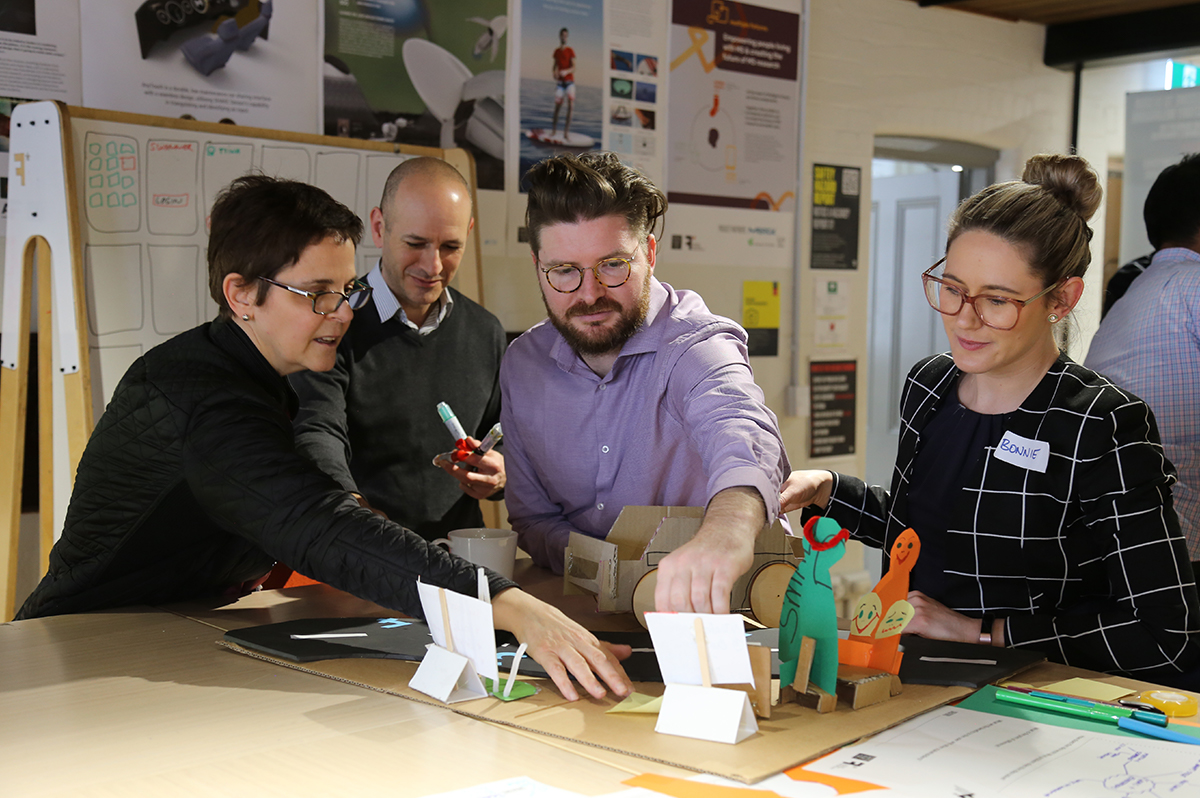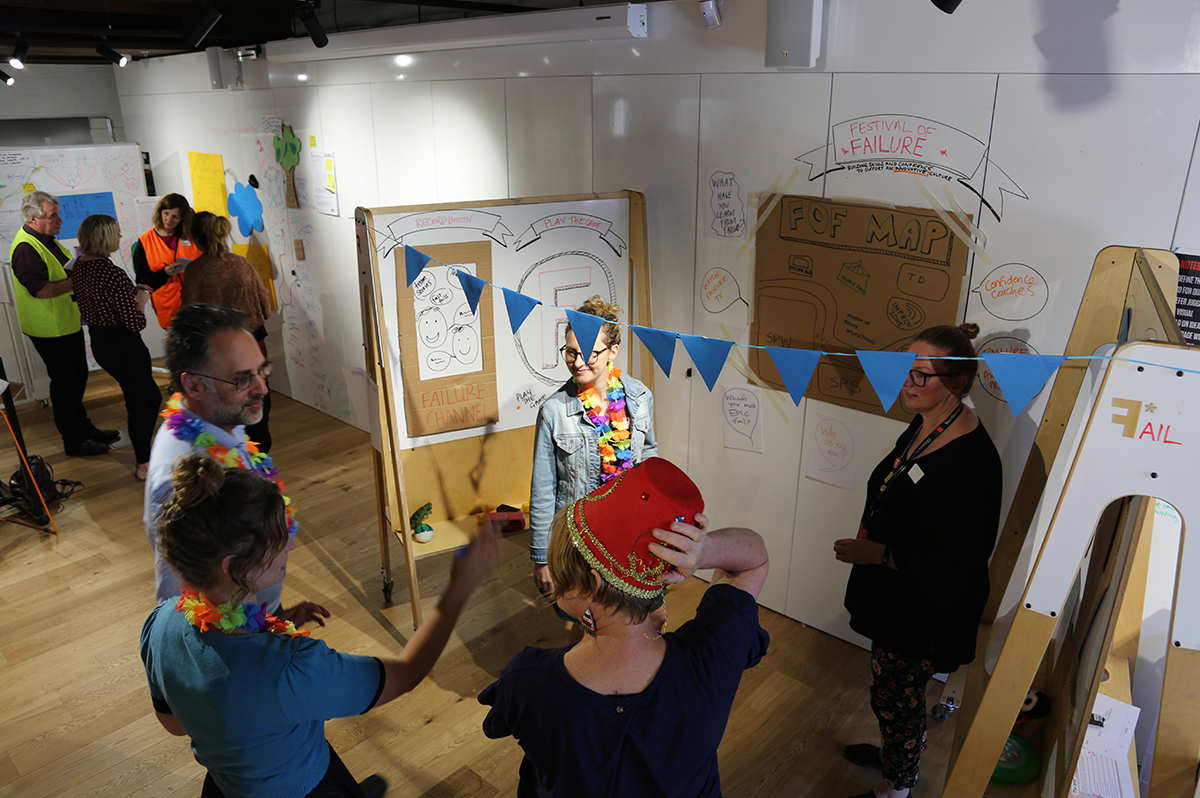Putting people first to drive innovation – key ingredients for staff capability building

Tiina Tuulos & Pauliina Mattila, DFM Workshop Team
Nicola Howard, Swinburne Business Partnerships
18 June 2020
Capability building is a common way to increase the competence of an organisation. Workshop design plays a major role on the type of benefits you gain from training as a participant and from an organisational perspective. This article outlines some of the benefits in two different staff training scenarios.
In the ever-increasing turbulent world, organisations are looking for ways to stay relevant and resilient. Specifically, numerous universities shape their strategies to become more agile, innovative, entrepreneurial and connected as a response to the changing needs of education and research. Staff training on new methods, skills or approaches is one way of increasing internal capability and introducing new ways of working which in the long term can lead to a more innovative organisation. Naturally, when investing time and resources to an in-person or online training, organisations hope to get the best return on investment for the time and effort used. However, research indicates that often these training and development activities don’t produce desired results (e.g. Arthur et al., 2003) and we don’t fully understand the effectiveness of the training (Martin, 2010; Sung & Choi, 2014). To impact training effectiveness, follow-up activities and learning transfer should be incorporated in the design of the training (Martin, 2010) and the client and facilitators need to work closely together to achieve this.
Over the past few years DFM has provided training on creative problem-solving, design thinking and creating conditions for innovation to different organisations in various forms and settings. Especially, through a staff training program designed for Swinburne, we have learned a lot in practice about the benefits and challenges of the way workshops are designed and delivered. There is a vast number of variables that we can address in capability building and training design, and in this article, we shed some light specifically into training individual employees versus existing teams (we call them cohorts) and opportunities that arise as a result.
During 2018 and 2019 Design Factory Melbourne was set a task to design and deliver innovation training for Swinburne employees initiated by Swinburne’s Business Partnerships team, and as a result, the Fearless Innovation program was developed. This workshop series, was a pathway for an employee to learn about innovation and creative problem-solving, acquire key tools and skills, and learn how to apply them in their own work. Altogether, we trained 200 staff members across the organisation. Staff members came from a range of roles and areas within the university, and primarily they were professional staff from different business units. The main component of the pathway was a 2-day bootcamp focused around innovation and it was organised in two different formats; a general bootcamp ran altogether seven times for individual staff members and a cohort-based training took place three times.

Key benefits of training range from creating unplanned connections to shaping complex challenges into tangible actions as a team
Through our research we’ve identified benefits in each training format. Regardless of the training scenario however, a key benefit is the increase in one’s confidence in taking on new practices and change in their mindset to be more receptive to creative thinking.
“Recognition that I can actually describe myself as creative, and capable of generating innovative ideas.”
In the general bootcamps with a mix of individuals from all across the organisation, as an immediate impact of the training participants highlight more practical tools and methods, hoping to share the learnings with their colleagues. As the participants come from a variety of different departments, the training was an opportunity to create new connections within the organisation, thus networking and meeting new people in training is a significant value-add. It builds a network of innovative staff members in the organisation and provides a mechanism to strengthen cross-departmental ties in the long-term. Furthermore, training for individual staff members provides the participants a different context altogether from the daily work environment. It may offer fresh perspectives both through interacting with colleagues who are slightly removed from the daily work and being in a different physical environment or context.
“I liked working in teams with staff from Swinburne I did not know prior to the workshop.”
In cohort-based training, one of the greatest benefits is that the format allows a more direct integration of the workshop design and content with the team’s daily work. Hence, the impact of the training may be more immediate. The alignment with the program focus and team’s strategy strengthen the ability to apply the new practices (Clark et al., 1993) as teams get to leave with not only new tools and skills, but also tangible outcomes and solutions, that they can build on and continue as a team. In addition, participants highlight the positive and inspiring atmosphere of the training enabling participants to collaborate as a team, hence the team building experience is an important positive by-product of cohort-based trainings.
“I think the Bootcamp definitely encouraged me to challenge our normal way of doing things. Just because a certain process or procedure has been in place, doesn’t mean that it necessarily always has to be done that way…”

What to remember regarding capability building design?
To boost the benefits of the capability building in both formats, there’s a number of actions that participants, facilitators and managers can do. Specifically individual staff members undertaking training tend to struggle to have the license and permission to designate time on training and feel the pressure to immediately disseminate and convey the insights from the training back to their team, as they have taken time out from the daily duties. This presents an opportunity to provide individuals with clear expectations and purpose prior to the workshop to justify the time spent on training. Furthermore, facilitators can provide supporting material to the individual participants’ direct line manager and team members as it is a mechanism to disseminate the training across the organisation.
In addition to taking responsibility to champion the new knowledge, individual participants raise challenges related to managerial support and ability to adopt new practices in their existing roles. This is aligned with the findings of Martin (2010) as managers’ role in supporting the adoption of new behaviours and practices coupled with peer-support is recognised as highly essential. Information sharing is fundamental in this scenario, as participants often face the situation where colleagues and managers are unfamiliar with the new content the participant has just acquired in training. In cohort-based training, information sharing is integrated in the workshop setting and thus experimenting with the new approaches is often easier.
“I would say this workshop is NOT a mere 2-day event, but is practically an on-going learning journey to continuously hone, improve and master the Design Thinking sets – skillset, toolset, knowledge set and mindset.”
To boost managerial and peer support, action statements and reflections on how to bring the new learning back to the daily context can be integrated into the training design and participants can be encouraged to share these with key stakeholders or a designated buddy from the team. This is a great mechanism to not only pass on information beyond the workshop situation but also to test how a participant has internalised training material. If possible, individuals should also consider encouraging a colleague to join the same training, to enable deeper reflection on the learnings and to have an accountability partner with whom to share the opportunity to transfer the new approaches into the daily context more effectively. Having shared the experience with someone you work with makes it easier to introduce new ways of working back to the rest of the team and alleviates the burden of a lonely change champion.
“Reason I would recommend [this training] is that it is good to have other team members have similar knowledge so we can put some of these concepts into practice.”
In cohort-based training teams feel more confident being in the joint training situation as the managerial mandate is built in and the whole team is committing time to the shared experience. For teams specifically, what managers and participants should focus on is to be able to shake up the existing behaviour patterns. Familiar setting with work colleagues may present challenges in existing teamwork and they may be resistant to change. Facilitators need to offer mechanisms to provide fresh perspectives in team dynamics and the workshop content, which can be achieved for example by providing tools and frameworks for teamwork or bring in other stakeholders to test and give feedback to experiments and development efforts.
“The Bootcamp enables participants to contribute on an equal footing, and to discover personal strengths that they may not ordinarily draw upon when collaborating in teams.”

The Bootcamp enabled individuals from all across the organisation to network with new colleagues and through sharing the experience, become a part of a community of practice that champions new ways of working within the organisation.
No one size fits all – pre and post training design key in training effectiveness
Cohort-based training tends to give participants and indirectly the organisation a head-start in changing behaviour as external factors such as the application of tools and methods, specifically their relevance in daily work, team alignment and managerial support are built into the training delivery format. In addition, during team training the participants most likely already know each other, but the training acts as a further team building exercise deepening the ties but also allows team members that don’t normally work together in day-to-day environment to bond.
On the other hand, from the organisational perspective, networking and new connections are beneficial (ties are completely new), as it promotes cross-departmental collaboration which builds towards a more effective cross-functional collaboration in the long run. When supported by their managers and peers, individuals all across the organisation have also the opportunity to disseminate and share the learning more broadly throughout the organisation, and thus the ripple effect of the impact of the training can be stronger. All in all, there are different benefits in each scenario, the format should be chosen depending on the aim and purpose of the training, and planning for what happens before and after training are as important as the training itself.
This article is based on a conference paper by Tuulos, Mattila & Howard (2019) published at the University-Industry Interaction Network conference in 2019, in Sydney, Australia.
References:
Arthur, W., Bennett, W., Edens, P.S. and Bell, S.T. (2003) “Effectiveness of training in organizations: a meta-analysis of design and evaluation features”, Journal of Applied Psychology, Vol. 88 No. 2, pp. 234-45.
Clark, C.S., Dobbins, G.H. and Ladd, R.T. (1993) “Exploratory field study of training motivation: influences of involvement, credibility, and transfer climate”, Group and Organization Management, Vol. 18 No. 3, pp. 292-307
Martin, H. J. (2010). Improving Training Impact Through Effective Follow-Up: Techniques and Their Application. Journal of Management Development, 29(6), pp. 520-534.
Sung, S. Y., & Choi, J. N. (2014) Do organizations spend wisely on employees? Effects of training and development investments on learning and innovation in organizations. Journal of organizational behavior, 35(3), 393-412.
Tuulos, T., Mattila P. & Howard, N. (2019). Putting people first – Exploring the impact of staff training to support the transition towards an innovative university. Proceedings of University-Industry Interaction Network (UIIN) 2019, 11-13 February 2019, Sydney, Australia.

